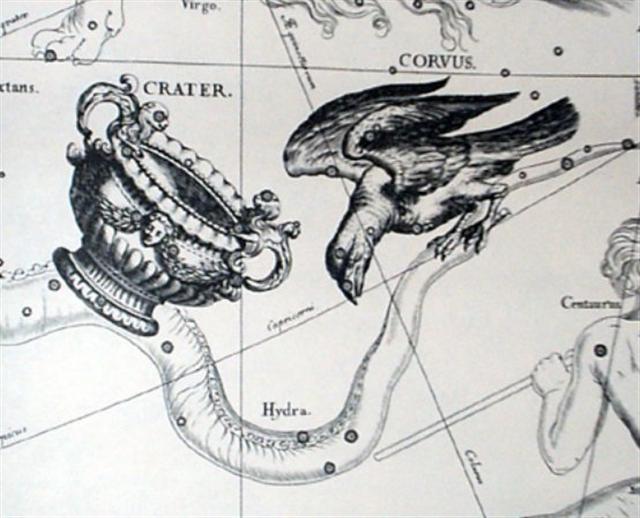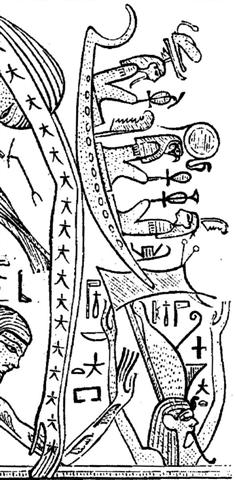There is a vacant glyph space in line Kb2 too:
A hole has been drilled in side b which goes through the wood where Kb2-5 should have been. This hole explains also the empty space immediately below and beyond the upside down Kb1-16:
I have copied the picture from Fischer and enhanced it somewhat. We can see how the physical limits of the tablet probably made the engraver create a text which could be harmonized with only partly visible glyphs at bottom and top. Likewise did he evidently use the drilled hole for his purposes. In line Kb1 it probably coincides with a position after Gregorian day 254 (= Alterf 13) and in line Kb2 with a position after day 182 from equinox:
Day 180 from equinox (at Kb2-2) has a very special henua with marks inside which perhaps refer to the balance between summer (top) and winter (bottom). The top wedge is open in front and the bottom wedge is closing in front. This is day 260 in the Gregorian calendar and in G the glyphs which follow could be allusions to the open π 'door' and the omikron 'egg' of Virgo:
In K, we then can realize, the open π door could be formed by arm, body, and leg of the running away ariki. Consequently we could also imagine the little non-completed honu to represent ο Virginis. This I could hardly had dared to suggest if it was not supported by the G text.
*Kb2-6 is probably to be connected with Ka1-3. We can be fairly sure the honu 'egg' in Kb2-4 coincides with ο Virginis and counting mechanically backwards (only visible glyphs) we will find the 'upper' henua in Ka1-3 to be at Aldebaran:
Strictly regarded this is not true, because according to my reconstruction there should be - somewhere between Ka1-3 and Kb2-4 - a change from my method of adding 65 to instead add 66 to the glyph numbers in order to reach the right ascension days. Or we could say that somewhere between 'May 28 and 'September 19 there seems to be a day with no corresponding glyph (a stellar 'leap day'). In Fish-hook of Maui I suggested it might have been 'July 12:
The K text seems to support my idea because the descending kahi (in Ka3-5) is followed by the heliacal rising in 'July 12 of the dead Castor. Furthermore, as a consequence Sirius could be at a tagata (just as in the G text). Below I have tried to move the stars up to Castor one glyph ahead in order to place Castor between Ka3-6 and Ka3-7:
Perhaps ρ Gemini is the star referred to as q Cancri (with the strange q indicating the mirror image of p): ... Its leading star is said to be 'q Cancri'. Strangely the internet site Chinese Astronomy never uses Greek letters for the stars, e.g. is Tejat Posterior (μ Gemini) referred to as 'm Gemini'. However, there is no Greek letter corresponding to the letter 'q'. Possibly the idea is to refer to the ancient Greek letter koppa, a reasonable sign for something dead and only living on in peoples' minds. There is no star q Cancri (or similar) according to Wikipedia ... The pieces of the puzzle fit together, because Aldebaran was once the great (red) star announcing the arrival of the summer 'year', while the idea of Raven announcing the arrival of the winter 'year' surely also should be ancient. Alchita (at Kb2-6) is α Corvi and 183.1 - 68.2 = ca 115. If anciently the year some times would have been counted as 460 nights long, then a quarter of it would have been 115 nights. When once Aldebaran was at spring equinox ca 90 days after the winter solstice Alchita would have been around day 90 + 115 = 205, i.e. according to our Gregorian model in day 80 + 115 = 195 or around July 14. Obviously the deep curve ('hole') in Hydra between Crater and Corvus could illustrate the end of 'summer' followed by the beginning of 'autumn'. Hevelius has the eye of Corvus as ε (Minkar) and Alchita at the beak:
But the beak ('tara') comes before the 'eye':
Possibly the ancient idea was that a 'hole' had to be poked by the 'beak' of the Sun Ship:
| |||||||||||||||||||||||||||||||||||||||||||||||||||||||||||||||||||||||||||||||||||||||||||||||||||||||||||||||||||||||||||||||||||||||||||||||||||||||||||||||||||||||||||||||||||||||||||||||||||||||||||||||||||||||||||||||||||||||||||||||||||||||||||||||||||||||||||||||||||||||||||||||||




















